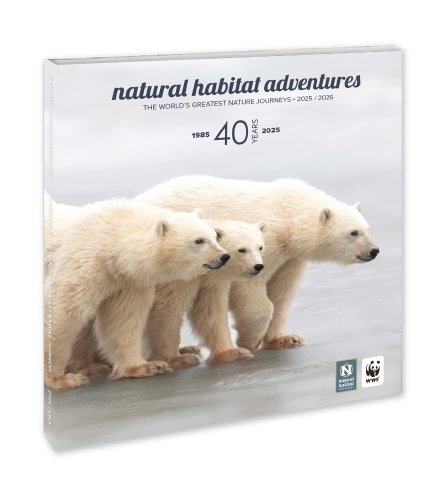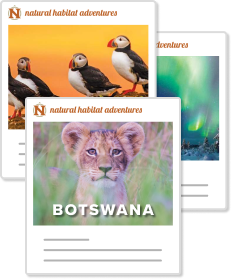Itinerary
Our Canyon Country photo itineraries allow extra time for patience with light conditions and elusive wildlife. Your guides are expert photography instructors, offering personalized guidance for photographers of all ability levels, helping you navigate challenging desert light conditions and other concerns. Photo tours are capped at 10 travelers.
Few landscapes are as frequently photographed as the American southwest canyonlands, a complex realm of foreground elements featuring intricate layers and shapes that seem to shift depending on the dramatic light. Here, the ravines and rivers lead the eye through the vast expanse, while the shadows evolve, depending on the sun’s location in the sky.
Our canyonlands adventure begins in the red rock country of St. George, Utah, which offers an abundance of red sandstone cliffs and formations, and slot canyons. This evening we meet for a welcome dinner at a local restaurant with our Photo Expedition Leader. Chosen for their photography and naturalist expertise, our guide will offer a brief overview of our journey ahead, including a primer on shooting images in this arid, striking realm. Learn about the history, geology, wildlife and ecology of the Colorado Plateau, which we explore in depth in the days to come on our foray through three of the world's most magnificent national parks.
Day 2: Bryce Canyon National Park—Dark Sky Experience
Today’s focus is landscape photography, and your Photo Expedition Leader will explain the art of capturing the rich red, yellow, orange and ochre hues of the surrounding geology as we drive the exhilarating route to Bryce Canyon. Along the way, we’ll stop at several scenic spots, possibly including Cedar Breaks National Monument and its yawning canyon, visible from the rim at 10,350 feet. To capture the half mile-deep geological amphitheater of stacked orange layers, fins and pinnacles, we’ll focus on composition, framing and exposure as we optimize the natural light. These features tell a fascinating story of dynamic natural forces throughout the Grand Staircase.
Later this afternoon we reach Bryce Canyon, established in 1925. This fantastical landscape feels like a portal to another world, and we’ll shoot its pink pinnacles, limestone formations and natural amphitheaters. You’ll have opportunities to experiment with silhouette and panoramic photography. Red rock walls are rent with deep channels while whimsical hoodoos—rock spires carved eons ago by erosion—rise hundreds of feet into the sky.
After dark, we’ll have our first astrophotography session under Bryce’s dark night skies. Joined by a dark night sky ranger, we head just outside the park boundary, away from any artificial light, to capture the astral sky in images. We’ll concentrate on wide angle and long exposure to make silky images of a starlit sky. Offering an extraordinary view of the cosmos, Bryce holds International Dark Sky status, and the absence of light pollution reveals more than 7,500 stars on a clear night, while the Milky Way arcs overhead. When there is a new moon, the sight is otherworldly, as planets, constellations and distant galaxies are visible. Hone your astrophotography skills tonight in anticipation of additional sessions in Zion and Grand Canyon.
Day 3: Photographing Bryce Canyon National Park
Capture the morning’s golden hour light as we set out early on foot today. As the sun climbs into the sky, the morning light fills the iconic Hood Amphitheatre. Your Photo Expedition Leader will advise on filters and hoods to reduce flare spots and lines. We’ll play with light and detail, zooming in and out to create images that document how different this ancient landscape can appear, depending on the conditions. Then, we continue our photo walk, descending roughly 550 feet into the lower canyon. Here the landscape is forested with pinyon pines and junipers, which offer a vibrant green contrast to the looming hoodoos. Here, nature’s power is writ large, and our images are an opportunity to reflect how small one can feel when immersed in its grandeur. [Guests who don’t wish to tackle the elevation gain can walk the paved trails on the rim.] In the afternoon, more opportunities await to photograph Bryce from different spots, including a panorama across the vast landscape of the natural amphitheater crowded with hoodoos.
Day 4: Bryce Canyon Sunrise / Zion National Park
We rise at dawn and head to the Bryce Canyon rim to shoot the soft morning light. Our Photo Expedition Leader can explain the advantages of starburst photos as we photograph a striking array of colors as the changing light illumines the stone pinnacles and sheer cliffs. A morning hike offers yet more angles on this wondrous landscape, more evocative with each turn in the trail.
Then it’s time to head for Zion National Park on one of the most scenic drives in the American Southwest. Keep an eye out for bighorn sheep as we follow the narrow two-lane road that cuts through canyons and twists below towering monoliths. As we approach Zion, we pass Checkerboard Mesa, a 6,250-foot landmark of striated Navajo Sandstone. Early Mormon pioneers gave Zion its name—so striking was its beauty that it evoked images of the biblical Promised Land. The U.S. government agreed and made it a national park in 1919. Multi-hued sandstone ramparts rise above the valley floor where the Virgin River flows among the cottonwoods, carving a deep canyon over millennia and blending lush greenery with dramatic rocks.
Day 5: Hiking in Zion National Park / Scenic Helicopter Flight
Begin the day photographing Zion Canyon on foot, following narrow trails below 2,000-foot cliffs of Navajo Sandstone. Our Photo Expedition Leader will discuss aperture and its importance when you’re shooting different subjects in the same place—like Zion’s prolific bird life and its and its remarkable landscape. The Virgin River carved this canyon millions of years ago, and using slow shutter speeds, we capture its elegant path and the life it sustains, like tiny wildflowers or mule deer and rock squirrels. Trails along the river lead to quiet recesses, where we may hear and see many birds unique to the American West: canyon wrens, golden eagles, prairie falcons, American dippers and phoebes, among others. Then climb higher for dramatic views of the towering canyon walls and shadowy depths below. Throughout the day, we task ourselves to capture Zion’s sheer size, using the massive canyon walls for perspective and focus.
And for even more perspective, enjoy a scenic helicopter flight in and around Zion National Park, featuring aerial views of Smith Mesa, Kolob Canyon and Red Butte Mountain, in addition to notable landmarks of the park itself. Note that photo opportunities are limited during the flight.
Day 6: Morning Hike in Zion / Grand Canyon National Park—North Rim
Following a peaceful morning hike in Zion, we travel south to the Grand Canyon, established in 1919. Lying entirely within the state of Arizona, the park encompasses 278 miles of the Colorado River and adjacent plateau. Located on the ancestral homelands of 11 tribal communities that hold the space sacred, Grand Canyon is one of the most spectacular examples of erosion anywhere on Earth. We’ll use the canyon’s natural layers as leading lines as we focus today on landscape composition.
Grand Canyon’s popularity can mean many visitors, so we avoid the bulk of the crowds by concentrating on the less visited but no less spectacular North Rim. With only 10% of the total number of visitors to the national park each year, this area proffers more secluded and uninterrupted photo opportunities. We spend two nights at Grand Canyon Lodge, tucked among the ponderosa pines at 8,000 feet on the canyon’s edge. The classic lodge, now a National Historic Landmark, is the only accommodation inside the park on the North Rim. Built in 1928 by architect Gilbert Stanley Underwood, the lodge on Bright Angel Point was constructed of native Kaibab limestone and heavy timber logs that capture the rustic national park style of the era. After a fire four years later, it was rebuilt in 1936, preserving the original stone, and that venerable structure endures today.
Our time at the Grand Canyon will be devoted to making pictures that tell the story of this special place. Humans have lived in the Grand Canyon region for 25,000 years, a mere blip in time compared to the 1.7-billion-year-old Vishnu Schist rocks visible along the Colorado River in the bottom of the canyon. Our relatively open schedule allows plenty of time to frame and shoot the drama of one of the planet’s most magnificent natural landscapes. It may be helpful to think of today as reconnaissance, practicing certain shots in preparation for tomorrow. We conclude the day with a sunset shoot.
Day 7: Grand Canyon Sunrise / Hiking the North Rim
Today is the culmination of all we have practiced—working with light (and its absence), natural leading lines, composition, exposure and detail. It’s also an opportunity to gaze into the mile-deep chasm of the Grand Canyon in the ethereal light of sunrise and sunset to capture the fleeting beauty in images. Our Photo Expedition Leader knows the best overlooks to capture the beauty of sunrise, including Cape Royal and Point Imperial, though really, any spot on the rim is going to offer a stunning experience. Sunset will likewise bring astonishment as we watch the canyon depths shift from orange and rust to pink and purple as the sinking sun casts its glow in contrast to with the shadows moving across the etched peaks and crevasses.
We spend the day on several hikes, tapping the deep knowledge of our Photo Expedition Leader who knows the best trails and viewpoints for a more secluded encounter with this extraordinary geological phenomenon. Capture vistas from different viewpoints along the rim and just below, enjoying moments of relative solitude. Tonight, we share a farewell dinner at the lodge. Then, step out onto the stone terrace for your last opportunity to capture the sunset and to shoot the Grand Canyon’s celestial wonders. The park was recognized as an International Dark Sky Park in 2019, after a three-year endeavor to protect its night skies by altering light fixtures and taking measures to reduce light pollution.
Day 8: Grand Canyon / St. George / Depart
Rise at dawn for your final chance to capture the sunrise over the North Rim before we depart after breakfast. Although you’re leaving this inspirational landscape, the anticipation of reviewing, editing and sharing your images builds. Soon you’ll be sharing the stories of America’s canyon country. For now, we travel back to St. George, arriving in time for afternoon flights home (book no earlier than 12:30 pm).
Please note: This itinerary is subject to change, as departures may visit Grand Canyon, Zion and Bryce in a different order than what is outlined above. Your precise itinerary will be communicated to you once your trip dates are confirmed.

























